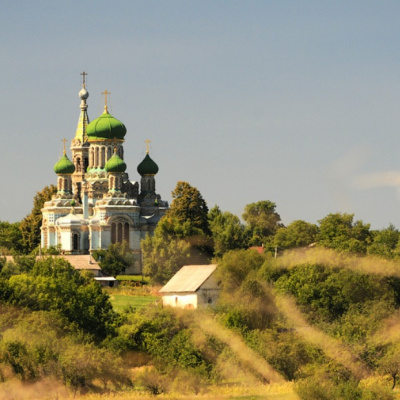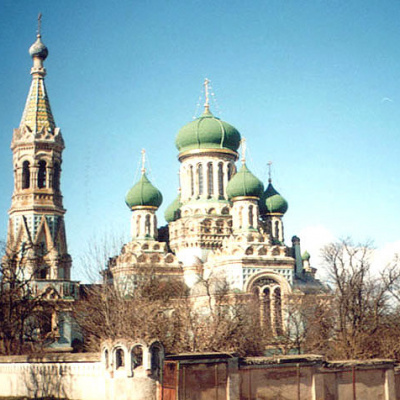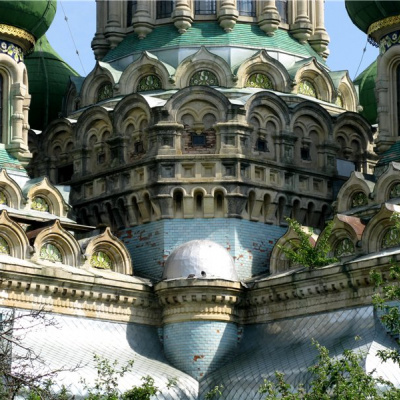Bila Krynytsia
The village of Bila Krynytsia is one of the most famous religious places in Bukovyna. It belongs to the Starovovchynets village council, and today it is a real Mecca for Christian pilgrims, antiquity lovers and ordinary tourists. The village is located on the border with Romania, 12 km from the district center. It is a world spiritual and historical center of the Old Believers. In 1996, the World Old Believer's Council was held in Bila Krynytsia. This small village on the border with Romania is known in the Old Believers' community for the fact that in 1846, on October 28, the three-fold hierarchy was restored here, when Metropolitan Ambrose joined the Old Believers in the rank of a priest. To mark the 160th anniversary of this celebration, the Consecrated Council of the Old Believer Church was held in the Ukrainian village of Bila Krynytsia (Bukovyna) on September 14-17, 2006.
The village of Bila Krynytsia in the Hlyboka district was the center of the Old Believers' settlement in Bukovyna and was chosen by them as the residence of the future Old Believer bishop. Russian Old Believers (also known as Lipovans or Pylypons) arrived in Bukovyna from the Black Sea region, Moldova, Wallachia, and Bessarabia in the 1760s and 1780s. The Austrian authorities, interested in settling Bukovyna, were favorable to the Old Believers. By the imperial patent of 1783, Joseph II exempted them from taxes for 20 years and guaranteed freedom of religion. For a small fee, the immigrants received land and were exempted from serfdom, as well as from military service for 50 years.
The Old Believers, or Lipovans, are Orthodox Christians who preserved the purity of the Russian faith after the church reform introduced in the second half of the seventeenth century by Patriarch Nikon with the participation of Tsar Alexei Mikhailovich of Moscow. Fleeing persecution for their faith by the Moscow authorities, some Old Believers fled to distant Siberia, while others, together with the Ukrainian Cossacks of Hetman Ivan Mazepa's army, which was defeated by Peter the Great's troops, settled along the banks of the Danube, proclaiming the Cossack-Old Believer Danube Republic.
However, their persecution did not stop, and the Old Believers, continuing to search for their "promised land," settled in Bukovyna, which, starting in 1774, came under the rule of the Austrian Empire. The Habsburgs, represented by Emperor Joseph II, known for their tolerance of all faiths, granted permission for Old Believers to settle in Bukovyna in 1783.
Bila Krynytsia became one of the first Lipovans settlements on Bukovyna's land. Twenty-two families headed by a wealthy Cossack, Nikifor Larionov, 7 Old Believer monks, and an abbot move here and found a monastery. On the basis of the monastery, the world's first Old Believer's See was established by the decision of the Old Believer's Council, which took place in 1832 at the Rogozske Cemetery in Moscow. The first metropolitan of the Bila Krynytsia diocese was former Metropolitan Ambrose of Bosnia and Sarajevo, who arrived in Bila Krynytsia on October 28, 1846, with the permission of the Austrian Emperor Ferdinand.
Throughout the newly created Old Believer diocese, churches began to be built and priests were appointed. However, the joy of the Bukovinian Old Believers was short-lived. When Tsar Nicholas I learned of the activities of Bishop Ambrose, who was also ordaining the Old Believer hierarchy for Russia, he threatened Austria with war and demanded that the Habsburgs close the diocese and the monastery. Already in December 1847, Ambrose was summoned to Vienna, offering him a choice: to renounce the leadership of the Old Believer diocese and head the diocese in Constantinople, or to go into exile forever. However, the bishop did not renounce his faith, and after 15 years in exile, he remained faithful to the Old Believers until the end of his days.
A few years later, however, the activities of the Bukovyna Old Believer Diocese were revived, and Bila Krynytsia became the spiritual center of the entire Old Believer movement for almost a century. At the beginning of the twentieth century, Bila Krynytsia had about 20 religious buildings: churches, cells, and other buildings. The most magnificent churches of the "Old Believer's Jerusalem" were the multi-domed Intercession Cathedral with a huge five-tiered bell tower 45 meters high and the winter St. Nicholas Church with a massive dome. It was in the Intercession Cathedral that Metropolitan Ambrose joined the Old Believer Church. At the end of the nineteenth century, a nunnery was also founded in Bila Krynytsia.
Unfortunately, today little remains of the former grandeur of the Old Believer capital. The Intercession Cathedral with its bell tower, St. Nicholas Church, and almost all of the monastery's religious buildings were barbarically destroyed by the Bolsheviks in the late 1940s. For almost half a century, the Lipovan ethnic group virtually ceased to exist.
The village got its name due to the fact that the water in the wells here is almost white in color: lime-laden and sweet in taste. From the end of the eighteenth century to the present day, Bila Krynytsia has been the center of the Russian Old Believer Church and a holy land for all Old Believers. Today, only two churches remain of the old monuments of religious architecture in Bila Krynytsia. The first of them, the Church of Kozma and Demian, is located at the beginning of the village to the right of the road. First built in the late eighteenth century, the church underwent reconstruction during the nineteenth century, during which it acquired its present appearance. The church has features of typical Bukovinian church architecture.
A true and unsurpassed masterpiece of religious architecture in all of Bukovyna is the Old Believer Assumption Cathedral, built in 1900-1908 by the Austrian architect W. Klick. The interior of the cathedral is represented by one large and two small iconostases made of oak by the best carvers from Volodymyr and painters from Palekhiv workshops. The cathedral's bell tower is also striking in its architecture and richness of exterior decoration. It is truly unique in the whole of Ukraine. It is higher than the cathedral, has four tiers, and its top is covered with colorful tiles. The bell tower offers a unique view of the Assumption Cathedral, Bila Krynytsia, and the surrounding area.
Today, the Old Believer's Museum Complex, which existed here since 1988 and was closed in 1996 due to lack of funds, is being revived on the territory of the Old Believer's churches in Bila Krynytsia. The construction of a two-story wooden building is nearing completion, which will house a refectory, cells, and a museum room. When visiting Bila Krynytsia, be sure to have your passport with you: the village is located in the border area.
Bicycle route
Cherepkivtsi - Staryi Vovchynets - Bila Krynytsia - Kamianka - Cherepkivtsi
Duration: 6 hours. Route length: almost 30 km. Height gain: 84 м.
The route starts at the bus station near the Vadul-Siret customs post in Cherepkivtsi and leads to the villages of Staryi Vovchynets and Bila Krynytsia via a railway crossing; then, past ponds and forest, the marked route leads to Kamianka, from where it heads back to Cherepkivtsi.
Along the route you can see:
- churches in the villages of Kamianka, Bila Krynytsia, Staryi Vovchynets, and Cherepkivtsi;
- local history museums in Bila Krynytsia and Staryi Vovchynets;
- the surrounding landscapes.



